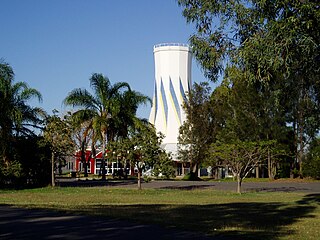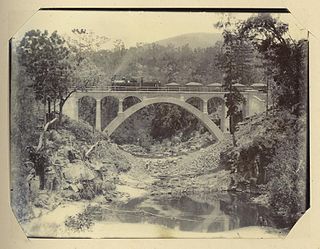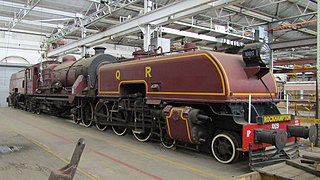
The Moura railway line is a railway in central Queensland, connecting several coal mines to the port of Gladstone. It connects the remnants of several lines that previously connected to Rockhampton, originally by a rack railway.

The Moura railway line is a railway in central Queensland, connecting several coal mines to the port of Gladstone. It connects the remnants of several lines that previously connected to Rockhampton, originally by a rack railway.
A branch line was built from near Rockhampton, opening in 1898, and another opened in 1917, both having a north–south alignment. In 1953 a spur line opened to serve the Callide Mine, and another to serve the Moura coal mine opened in 1963, both mines shipping coal to Gladstone via Rockhampton, a ~270 km distance. As coal volumes grew a direct line to Gladstone was proposed, and the 151 km Moura Short Line opened in 1968, being the first 'S' (Special) class line in Queensland, with an 18 tonne axle load at the time. [1] It commenced at Graham railway station (in Calliope) on the Monto line, connecting to the Callide Valley line (and the Callide Coalfields) at Earlsfield railway station (in Jambin), and connecting to the Dawson Valley line at Moura Mine Junction, 12 km east of the town of Moura.
Before the Moura Short Line opened, the largest QR steam locomotive, known as a Garratt, could haul a 750-ton coal load to Gladstone via Rockhampton. After the line opened, triple headed diesel hauled trains took 4000 ton coal loads direct to Gladstone.
Additional coal mines were developed in the area, and a 5.6 km line from Annandale to Boundary Hill Mine opened in 1983. A balloon loop and 5.6 km connecting line was opened at Moura Mine in 1994.
As Gladstone is the major port for central Queensland, the majority of freight began to be railed via the new direct line, and the 69 km Kabra-Wowan and 47 km Baralaba-Moura sections of the Dawson Valley line closed in 1987, effectively shifting the network to an east–west alignment.
Further sections subsequently closed such as Thangool-Biloela (11 km) in 1988, Goolara-Theodore (5 km) in 1993, Wowan-Rannes (25 km) and Kooemba-Baralaba (12 km) in 1995, Rannes-Kooemba (25 km) in 1997 and Rannes - Koorngoo (24 km) in 1999.
On 26 June 2013 the Earlsfield-Koorngoo, Dakenba-Biloela and Moura-Goolara sections were closed, [2] leaving the system as a 192 km line from Graham to Moura, with a 29 km branch to Callide Coalfields and ~3 km balloon loops at the Boundary Hill and Moura mines.
Today coal is the main freight hauled on the Moura line, with grain from the silos at Moura being significant, if seasonal, traffic. The line from Dakenbah to Biloela has been removed.
The Moura line as far as the Moura balloon loop features 60 kg/m rail on concrete sleepers, a 26.5 tonne axle load, maximum grade of 1 in 63 (~1.6%) eastbound (1 in 50 (2%) westbound), 300m minimum radius curves and a line speed of 80 km/h except for the 10 km section crossing the Calliope Range, which has a 40 km/h speed limit. Beyond that the line has 30 kg/m rail, a 15.75 tonne axle load and a 40 km/h speed limit.
The section from Earlsfield to Callide Coalfields via Dakenba features 53 kg/m rail, a 26.5 tonne axle load and curves with a minimum radius of 160m.
A major coal mine is proposed at Wandoan, with coal to be shipped from Gladstone via the proposed Surat Basin railway, which would connect to the Moura line south of the town of Banana. This proposed line would be well east of Taroom, and pass close to the gold mining town of Cracow.

Biloela is a rural town and locality in Shire of Banana, Central Queensland, Australia. It is situated 120 kilometres (75 mi) inland from the port city of Gladstone at the junction of the Burnett and Dawson highways. Biloela is the administrative centre of Banana Shire, which has an area of 15,729 square kilometres (6,073 sq mi). In the 2016 census, Biloela had a population of 5,758 people.

The North Coast railway line is a 1,681-kilometre (1,045 mi) 3-foot 6-inch gauge railway line in Queensland, Australia. It commences at Roma Street station, Brisbane, and largely parallels the Queensland coast to Cairns in Far North Queensland. The line is electrified between Brisbane and Rockhampton. Along the way, the 1680 km railway passes through the numerous towns and cities of eastern Queensland including Nambour, Bundaberg, Gladstone, Rockhampton, Mackay and Townsville. The line though the centre of Rockhampton runs down the middle of Denison Street.
Aurizon, formerly QR National, is a freight rail transport company in Australia, and the largest of its kind in the nation. Formerly a Queensland Government-owned company, it was privatised and floated on the ASX in November 2010. The company was originally established in 2004–05 when the coal, bulk, and container transport divisions from Queensland Rail were brought under one banner, as QR National.

The rail network in Queensland, Australia, was the first in the world to adopt 1,067 mm narrow gauge for a main line, and now the second largest narrow gauge network in the world, consists of:

The Blackwater railway system is located in Central Queensland and services the coal mining area of the Bowen Basin. It carries coal, as well as products, to other destinations by way of connections to the North Coast Line at Rocklands and the Goonyella Line via Gregory coal mine to Oaky Creek. Together with the Moura line the two railway systems are known as the Capricornia Coal Chain.
In the late 1970s and 1980s, a significant rail electrification program was completed in the Australian state of Queensland. The electrified Queensland network is the largest in Australia with over 2,000 kilometres electrified, the next biggest is New South Wales with 640 kilometres, that is served mainly as passenger operations.

Queensland's railway construction commenced in 1864, with the turning of the first sod of the Main Line by Lady Diamantina Bowen, the wife of Queensland's first governor Sir George Bowen at Ipswich, Queensland, Australia. A narrow gauge of 3 ft 6 in was selected due to cost savings in providing a rail link to Toowoomba. Despite being built with bridges wide enough for standard gauge, and the fact that most other lines did not require heavy earthworks, the gauge remained the Queensland system norm.

Mount Morgan railway station is a heritage-listed railway station at Railway Parade, Mount Morgan, Rockhampton Region, Queensland, Australia. It is on the Mount Morgan - Wowan railway line. The station was constructed in 1898 to service the former goldrush and gold mining township of Mount Morgan and its mine. The station was designed by Henrik Hansen, who also designed the Archer Park, Shorncliffe and South Brisbane railway stations. The station operated as a functional railway station from 1898 until 1987, after which it was restored as a Railway Heritage Museum. The museum includes artefacts from the rail and mining history of Mount Morgan, including a restored Hunslett steam engine, "Silver Bullet" rail motor and timber rail carriages. The station was added to the Queensland Heritage Register on 21 October 1992.

The Mungar Junction to Monto railway line is a 267 kilometre railway in Queensland, Australia. Progressively opened in eleven stages between 1889 and 1928 the line branched from the North Coast line at Mungar Junction a short distance west of Maryborough and followed a westerly route towards Biggenden and Gayndah before turning north via Mundubbera and Eidsvold to Monto. It is also known as the Gayndah Monto Branch Railway.
Byellee to Monto Branch Railway was a branch railway that branched off the Boyne Valley west of Gladstone in Queensland, Australia. However, the Boyne Valley region was predominantly a dairying region and a railway had little justification. However a branch was justified in 1906 on the basis of large traffic in timber, fuel, limestone and flexing ores. Progressively opened between 1910 and 1931 the line branched from the North Coast line at Byellee a short distance west of Gladstone and struck a south-westerly route via Many Peaks and Mungungo to Monto.
The Callide Valley railway line ran from Rannes to Lawgi in Queensland, Australia. The Callide Valley lies to the south-west of Rockhampton in Central Queensland.

The Dawson Valley Branch Railway was a railway line in Central Queensland, Australia. It opened in a series of sections between 1898 and 1927, and featured a rack railway section, one of only 3 such systems in Australia.

The Wandoan Branch is a 70 km railway line in the Darling Downs region Queensland, Australia. It links the towns of Miles and Wandoan. It was approved to extend to Taroom, but construction halted during World War One and never recommenced.

The Queensland Railways Beyer-Garratt class locomotive was a class of 4-8-2+2-8-4 steam locomotives operated by the Queensland Railways.
Some of the more notable coal companies in Australia are the following:

The Tatanagar–Bilaspur section is part of the Howrah–Nagpur–Mumbai line and connects Tatanagar in the Indian state of Jharkhand and Bilaspur in Chhattisgarh. Part of one of the major trunk lines in the country, it passes through an industrial-mining area and handles high volumes of freight, particularly coal and iron ore.

The Western railway line is a narrow gauge railway, connecting the south-east and south-west regions of Queensland, Australia. It commences at Toowoomba, at the end of the Main Line railway from Brisbane, and extends west 810 km to Cunnamulla, passing through the major towns of Dalby, Roma and Charleville, although services on the 184 km section from Westgate to Cunnamulla have been suspended since 2011. The Queensland Government was the first railway operator in the world to adopt narrow gauge for a main line, and this remains the system-wide gauge.

The Central Western railway line is a railway line in Queensland, Australia. It was opened in a series of sections between 1867 and 1928. It commences at Rockhampton and extends west 863 kilometres (536 mi) to Winton.

The Collinsville – Newlands – North Goonyella line, also known as the Goonyella – Abbot Point (GAP) line and the Newlands railway system, is a railway line in Queensland, Australia. It was opened in a series of sections between 1922 and 2012. It commences at Merinda, near Bowen and extends south to North Goonyella coal mine, connecting to the Goonyella railway line. The nearby 13 km line from Kaili to Abbot Point is considered part of the GAP system.